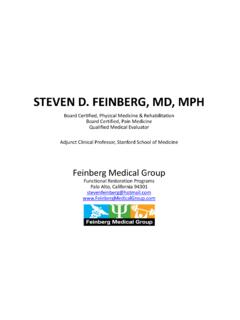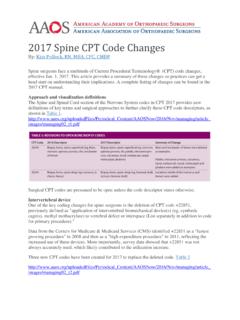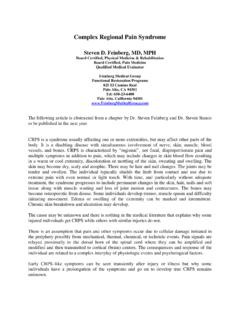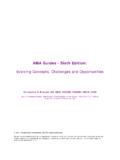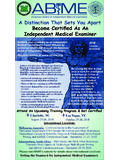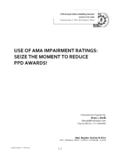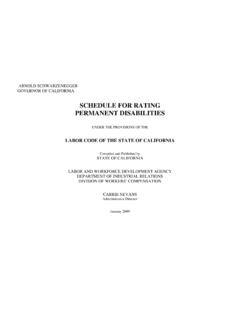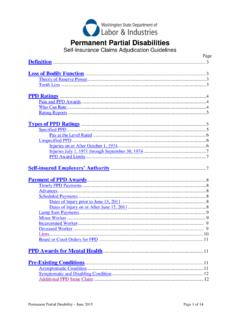Transcription of AMA Guides 5 Edition - COA
1 AMA Guides 5th Edition Almaraz-Guzman II: The Most Accurate Impairment Steven D. Feinberg, Board Certified, Physical Medicine & Rehabilitation Board Certified, Pain Medicine Adjunct Clinical Professor Stanford University School of Medicine Feinberg Medical Group Functional Restoration Programs Palo Alto, California WCAB Conclusions A permanent disability rating established by the Schedule is rebuttable Burden of rebutting a scheduled PD rating rests with the party disputing it Rebutting WPI under the AMA Guides WCAB Conclusions When determining an injured employee's WPI.
2 It is not permissible to go outside the four corners of the AMA Guides However, a physician may utilize any chapter, table, or method in the AMA. Guides that most accurately reflects the injured employee's impairment WCAB Caveats The WCAB emphasizes that their decision does not permit a physician to utilize any chapter, table, or method in the AMA Guides simply to achieve a desired result, , a WPI that would result in a permanent disability rating based directly or indirectly on any Schedule in effect prior to 2005 . WCAB Caveats The WCAB emphasizes that A.
3 Physician's opinion regarding an injured employee's WPI under the Guides must constitute substantial evidence;. therefore, the opinion must set forth the facts and reasoning which justify it Moreover, a physician's WPI opinion that is not based on the AMA Guides does not constitute substantial evidence First Step The evaluating physician needs to first provide a WPI using the AMA Guides in a standard, literal, strict or traditional approach and keeping within the chapter for the relevant body part When Almaraz-Guzman II? Almaraz-Guzman II states that Once a treating physician, AME, or QME has offered an opinion regarding the injured employee's WPI under the AMA Guides , then the injured employee or the defendant may seek to challenge that opinion through rebuttal evidence.
4 Confusion over this issue Activities of Daily Living The AMA Guides states that Impairment percentages or ratings developed by medical specialists are consensus-derived estimates that reflect the severity of the medical condition and the degree to which the impairment decreases an individual's ability to perform common activities of daily living (ADL), excluding work . Addressing Almaraz-Guzman II. In regards to actually addressing Almaraz- Guzman II, it seems very clear that it is critical to analyze the injured workers activities of daily living (ADLs).
5 If a standard WPI does not take into account significant ADL deficits, then this would be a justification for applying Almaraz-Guzman II. ADLs & Credibility Issues Activities of daily living are subjective Something that the injured worker describes to the evaluating physician While respectful of the patient's report regarding functional limitations in ADLs, the physician must determine if this report is consistent with the objective medical findings Objective Findings Apply A-G II if the strict WPI does not adequately address legitimate objective medical factors/pathology What Does Most Accurate Impairment Rating Mean?
6 The term accurate is not given in any context by the WCAB. We can assume that the term accurate impairment rating refers to a relationship between the industrial injury and the permanent effects an objective medical condition has on the injured employee's ability to perform ADLs Controversial Issues The question becomes which ADLs we are talking about? Rebuttal is to a scheduled permanent disability rating Activities of Daily Living (ADL). Home Work Defense will Argue AMA Guides ADLs Self-care & personal hygiene: Urinating, defecating, brushing teeth, combing hair, bathing, dressing oneself, eating Communication: Writing, typing, seeing, hearing, speaking Physical activity: Standing, sitting, reclining, walking, climbing stairs Sensory function: Hearing, seeing, tactile feeling, tasting, smelling Non-specialized hand activities: Grasping, lifting, tactile discrimination Travel: Riding, driving, flying Sexual function: Orgasm, ejaculation, lubrication, erection Sleep.
7 Restful, nocturnal sleep pattern Applicant will argue for Work ADLs (since the goal is to provide an accurate permanent disability award). Also consider pacing (speed of activity), repetition (repetitive activities), time (prolonged activity), and positioning (static or awkward posturing) factors Bottom Line It is critical that the physician's report provide a WPI that is the most accurate reflection of the impairment that meets the criteria of being substantial medical evidence Provide different "scenarios" that address the concerns of both the applicant and the defendant - leave the final decision about what is substantial evidence to the WCAB.
8 Functional Capacity Evaluation Functional Capacity Evaluations (FCEs). Functional Capacity Assessments (FCAs). Work Capacity Assessments (WCAs). Valuable in determining an individual's loss of work and self care (ADLs) capacity and retained abilities Useful in assessing work ability while defining areas of inability that can be treated . Most Accurate Reflection of the Impairment Rating by Analogy &. Other Approaches The AMA Guides State: After all potentially impairing conditions have been identified and the correct ratings recorded, the evaluator should select the clinically most appropriate ( , most specific) method(s) and record the estimated impairment for each (5th ed, 526).
9 Typically, one method will adequately characterize the impairment and its impact on the ability to perform ADL. In some cases, however, more than one method needs to be used to accurately assess all features of the impairment (5th ed, 527) . Rating by Analogy A similarity between two things When the WPI is not the most accurate, consider other impairments that create a similar effect on ADLs Support for Rating by Analogy On page 11, the AMA Guides states : Given the range, evolution, and discovery of new medical conditions, the Guides cannot provide an impairment rating for all impairments Also, since some medical syndromes are poorly understood and are manifested only by subjective symptoms.
10 Impairment ratings are not provided for those conditions Support for Rating by Analogy The Guides nonetheless provides a framework for evaluating new or complex conditions Most adult conditions with measurable impairments can be evaluated under the Guides Support for Rating by Analogy In situations where impairment ratings are not provided, the Guides suggests that physicians use clinical judgment, comparing measurable impairment resulting from the unlisted condition to measurable impairment resulting from similar conditions with similar impairment of function in performing activities of daily living.
